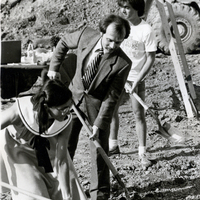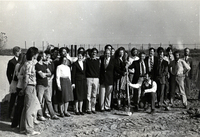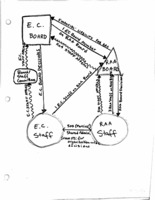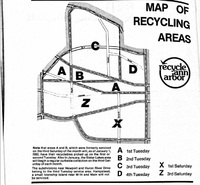Merger with Recycle Ann Arbor
"Combining Ann Arbor’s two major recycling operations is a natural outgrowth of more than a decade of work by the two groups...The Ecology Center and Recycle Ann Arbor hope to fill a void left by the city and by local waste haulers: the need for an efficient curbside recycling service which can be a part of the routine for every Ann Arbor household.” -Jim McCargar, Ecology Report, Vol. 14 No. 3, April-May 1982.
Building Capacity
The 1982 merger between the Ecology Center and Recycle Ann Arbor made that year a watershed moment for recycling in Ann Arbor. The organizations had begun cooperating in 1978 when Recycle Ann Arbor became Michigan's first curbside recycling program. From 1980-82, the EC and RAA shared a recycling facility on South Industrial Highway, expanded curbside recycling to reach a fifth of Ann Arbor homes, and quadrupled the availability of commercial recycling. The merger enhanced these organizations’ ambitions to transform Ann Arbor into a leading example of community-based recycling.
The EC-RAA merger took place in two phases. The first involved obtaining a new recycling truck, glass-crushing equipment, and opening a new recycling facility that could sort paper and create paper bales. RAA broke ground on a new wastepaper processing facility on Ellsworth Road in the late summer of 1982 and operations began in November of that year.
With increased capacity at the Ellsworth Road site and a larger fleet of specialized recycling vehicles, curbside recycling could reach more Ann Arbor neighborhoods. Participation in - and enthusiasm for - recycling skyrocketed. An article in the Nov. 1982 issue of Ecology Report noted that curbside service had expanded to 6,000 households. This figure suggested RAA was well on its way to achieving the 60% of households needed for the organization to be financially sustainable.
Growing Pains
Though both organizations prioritized environmental stewardship and sustainable resource use, Wendy Wilson, one of the founding members of RAA, recalls that the decision to merge organizations was a difficult one:
"We needed a whole new system, a new business plan for recycling in Ann Arbor. So, Recycle Ann Arbor thought that the Ecology Center was a bunch of old fuddy-duddies, and that they would never get it together to have a good service in the city. And the Ecology Center thought that Recycle Ann Arbor was a bunch of fly-by-night kids. And so that culture was hard to work with."
Both groups realized expanding recycling to serve the larger Ann Arbor community required an ongoing financial commitment from the city. RAA needed EC's established reputation to make that expenditure acceptable to city officials. The two organizations settled on a "wholly-owned subsidiary model." This structure allowed RAA to keep its identity while transferring administrative work to the EC.
Effects of the Merger
The EC-RAA merger proved to be a fruitful one for increasing knowledge and action about recycling. A key means of public outreach involved volunteer block coordinators who promoted awareness by distributing door-hanger reminders about recycling pick-up dates and conveying information about monthly featured items that RAA wanted citizens to recycle. By 1984, the RAA had enlisted 150 block coordinators from neighborhoods across the city.
In 1985 - only three years after merging with the EC - RAA reached its goal of city-wide curbside recycling. Statistics for the 1985-86 fiscal year reported a record 20,000 households per month participating in the program. That year, recycling activities collected approximately 2,200 tons of paper, cardboard, glass, and metals equivalent to 10,000 cubic feet of landfill space. Another success came in the form of recognition by the city government and $187,000 in funding. By the mid-1980s, RAA activities included the administration and promotion of the program, curbside pick-up, station drop-off, commercial pick-up and processing, and shipping.
Despite its success, toward the end of the 1980s committee members revisited the relationship between the RAA and the Ecology Center. At a June 1987 retreat, participants discussed the future of RAA as part of the EC. In deciding what the ongoing relationship should be, suggestions ranged from dissolving the shared board of directors that had been formed in 1982 to restructuring the existing leadership entirely. Part of the concern over RAA leadership had to do with expertise. As Bryan Weinert explained in a memo to the EC Board of Directors, RAA needed a new board with operations engineers and systems analysts who could make “intelligent, forward-looking decisions.” The question of technical expertise, overall vision, and RAA’s financial sustainability remained a serious and enduring one through the late 1980s and early 1990s.





